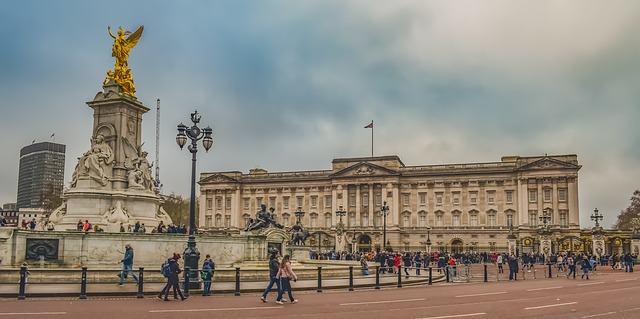
Undoubtedly one of the world’s most recognisable buildings, Buckingham Palace has been the London residence of the British monarch since 1837. Forming the backdrop for countless tourist photos, the palace has undergone many changes through the years.
Architecture and design
Formerly Buckingham House, the bulk of the structure dates from 1703 when a townhouse was built for the Duke of Buckingham. In 1761, it was acquired by King George III to be used as a private residence by Queen Charlotte.
The palace was remodelled by George IV in 1826 with the help of the architects John Nash and later Edward Blore. The modifications were inspired by French Neoclassicism and crafted from Bath stone. The palace was enlarged further during Queen Victoria’s reign with the addition of two new wings – in 1913, the last major work took place when the East front facade was redesigned in Portland stone.
The palace during World War II
During the onslaught of the Blitz, the palace was subjected to nine direct hits by German bombers. The most serious strike occurred on the 13th September 1940, when five high explosive bombs damaged the royal chapel, inner quadrangle, palace gates, and the Victoria memorial. The impact blew out windows, ruptured a water main and injured four palace officials, one of whom later died.
Royal births at the palace
Before Princess Anne started the trend of giving birth in hospital in the late 1970s, royal births typically took place in the palace. They are still announced by an official royal notice on a golden easel in the forecourt of the palace.
In anticipation of the birth of Prince Charles in 1948, the Belgian Suite was transformed into a maternity ward where Princess Elizabeth endured a 30 hour labour. As was the norm at the time, her husband Prince Philip was not present – he had to cut short a game of squash when informed of the birth. Arriving at the delivery room bearing a bouquet of red roses and carnations, he remarked that Charles reminded him of ‘a plum pudding’.
The art gallery
The site of the Queen’s Gallery was originally home to one of three identical conservatories designed by John Nash. Converted into a private chapel by Queen Victoria in 1843, it was destroyed by an air raid in 1940. In 1962, the ruined chapel was redeveloped as a public art gallery to house the Royal Collection. A major expansion of the gallery was completed in 2002 to coincide with the Golden Jubilee celebrations. Visitors to the gallery can enjoy masterpieces by Rembrandt, Vermeer, Titian and many others.
The intruder
One of Buckingham Palace’s most infamous incidents occurred on the morning of July 9, 1982. At around 6:45, 33 year old Michael Fagan scaled the palace railings and entered the building through an unlocked window. Discovering that the doors to the rest of the palace were locked, he exited through the window before climbing up a drainpipe onto the roof.
Taking advantage of another unlocked window, he wandered the palace halls, eventually making it into the Queen’s bedroom. After Fagan pulled back the curtains of her four-poster bed, she calmly pushed her night alarm bell, but to no avail. After 6 minutes and two calls to the palace police, a maid entered and lead Fagan away to the pantry with the promise of a cigarette. He was eventually led out of the palace by the police. The Royal Family’s surprising yet intentionally unobtrusive security were significantly strengthened following the remarkable incident.

Follow itravelnet.com